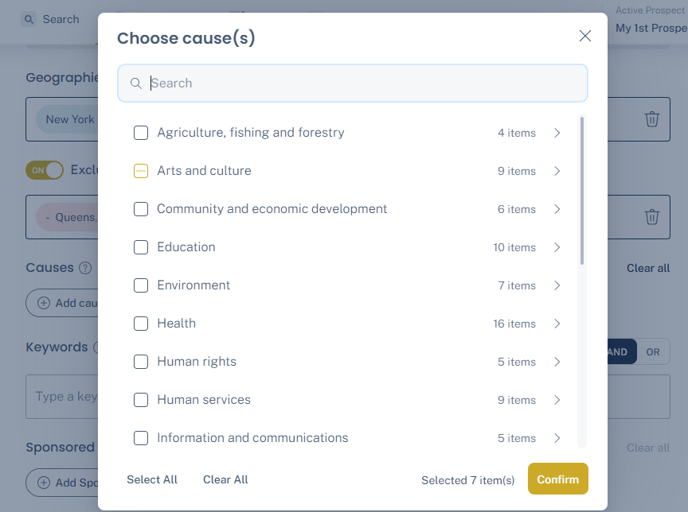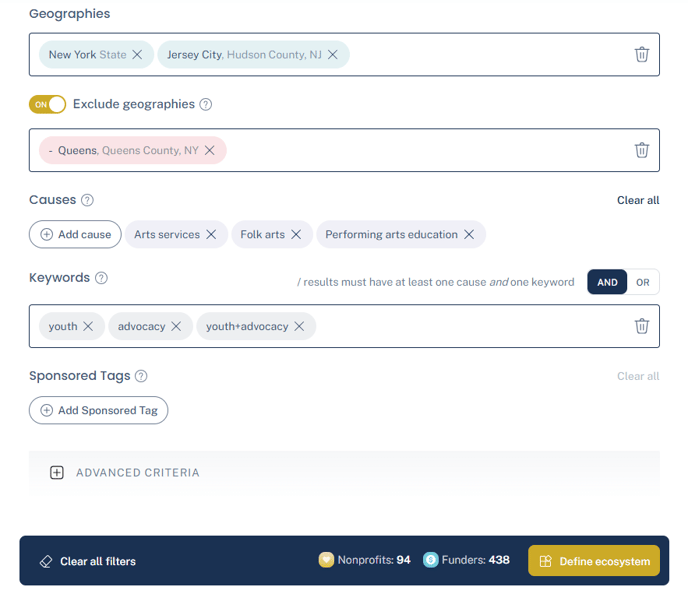How to build an Ecosystem around geographies and cause areas.
Ecosystems access is available with a premium subscription.
For information on Core access to Ecosystems - see step 3 here.
If you're looking for funding - pick cause areas, keywords, and/or locations that align with your organization. This will include all the nonprofits that fit these filters. It will also include all of their funders so you can see who is funding organizations like yours.
If you're looking for nonprofits to support or trends - pick cause areas, keywords, and/or locations that create the landscape you're looking to learn more about and possibly support. This will include all the nonprofits that fit these filters and their funders.
Step 1
Select Ecosystems from the top navigation bar, then select to research "A sector".
.png?width=680&height=372&name=2025%20Knowledge%20Base%20Images%20(4).png)
Step 2
Click inside the Geographies box to add the geographies you'd like included in your Ecosystem. Type into the box to look up cities, counties, and states based in the US.
To search the whole united states, leave this box empty.
.png?width=680&height=428&name=2025%20Knowledge%20Base%20Images%20(5).png)
With premium access, you can add multiple locations, and even exclude geographies.
Ecosystems will find all nonprofits that are located in ANY of the selected geographies (i.e. at least one).

Step 3
Click the + Add cause button to add in the causes you're interested in searching.
Cause areas have been pulled from IRS NTEE codes but also expanded. You can type to search for a cause area or look through the menu of categories and subcategories.
Ecosystems will find all nonprofit profiles that include ANY of the causes entered (i.e. at least one) and are located in the geography defined above.
Select your cause(s) and click Confirm.
Step 4
If you'd like to narrow or expand your search further, try adding in Keywords.
Click in the Keywords box and type a free text word or phrase, then hit enter. Ecosystems will search for nonprofits with the keyword in their name or mission statement.
With premium access, you can add in multiple keywords to broaden your search.
Tip: With the AND option selected, Impala will search for the combination of causes and keywords together, which will narrow your search.
With the OR option selected, Impala will search for either the causes or keywords that have been selected, which will expand your search.
If you want to search for multiple terms together, try using a "+" to add them as a single keyword. For example, adding in "youth" and "advocacy" will search for nonprofits with either "youth" OR "advocacy" as a keyword. If you instead search for "youth + advocacy", you'll get nonprofits with BOTH words in their name or mission statement, which will refine the ecosystem.
Step 5
Click the Advanced Criteria button to add any additional filters to your Ecosystem. You can search for specific Funders or Nonprofits to exclude them, include or exclude organizations by attribute, set a minimum and/or maximum on the operating budget or assets of the nonprofits in the Ecosystem, or exclude grants given through Donor Advised Funds (DAFs).
.png?width=475&height=415&name=2025%20Knowledge%20Base%20Images%20(6).png)
Step 6
You can preview the number of nonprofits and funders that will be in your Ecosystem on the bottom blue bar. Once you are happy with all the criteria you set, you can view the full Ecosystem by selecting the gold Define Ecosystem button.
Explore
Your Ecosystem is now ready for you to explore! If you want to change your filters, select Edit Filters from the top left. If you want to revisit the Ecosystem, select the save icon on the upper right, or click the pencil icon next to the auto-generated name.
.png?width=687&height=370&name=2025%20Knowledge%20Base%20Images%20(8).png)



.png?width=687&height=454&name=2025%20Knowledge%20Base%20Images%20(7).png)